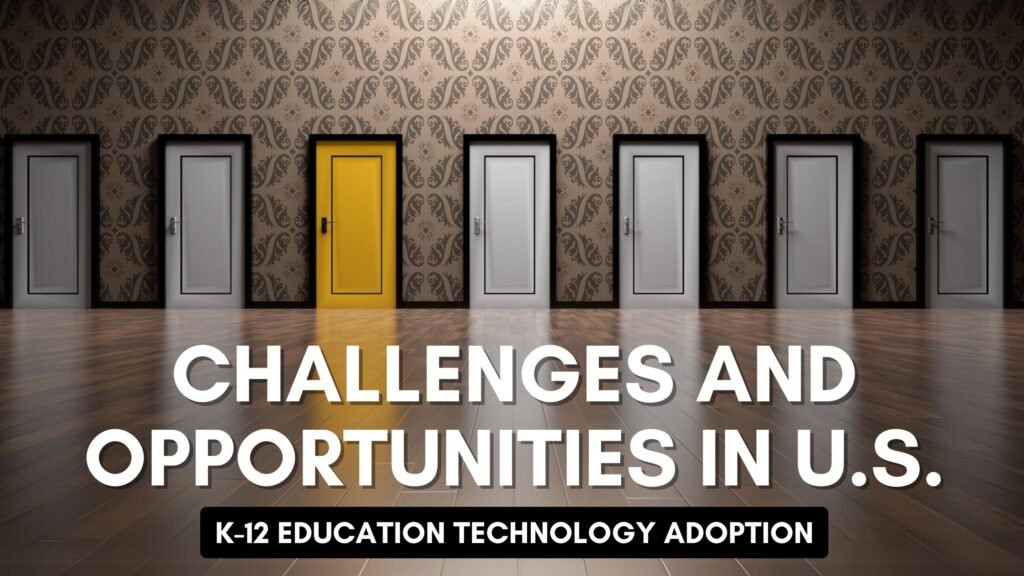The digital transformation of K-12 education in the United States is an evolving process, marked by both significant challenges and promising opportunities. When the COVID-19 pandemic came, schools rapidly adopted digital tools to facilitate remote learning. Even after the pandemic, they continue to use these tools to bridge the gap in traditional education. However, the path to effective technology adoption in K-12 schools is fraught with obstacles, from digital literacy gaps to resource constraints. This blog explores the current state of EdTech in U.S. K-12 schools, the key challenges they face, and actionable strategies to overcome these barriers while examining future trends that promise to shape the landscape of digital education.
Current State of EdTech in U.S. K-12 Schools
The current and future use of educational technology (EdTech) in U. S. K-12 schools has changed significantly because of the COVID-19 crisis. COVID-19 learning has pushed the use of digital resources and therefore speeds up the process of installing learning technology. Tools such as Google Classroom, Zoom, and Microsoft Teams have become part of daily teaching and learning practices whereas learning management systems have been used for enhanced teaching and instruction as well as administration of coursework and assessment purposes.
Nevertheless, the adoption of such technologies is also evident that the implementation identifies that the readiness level is not equal for all the schools. An example of New York City’s public schools showed that rather than struggling like most districts, urban districts with the resources could switch to online learning almost immediately while rural and low-income schools did not have access to the internet and devices. It is beyond doubt that the pandemic has worsened the existing digital divide, and thus implies that though technology makes education better it is not achieved equally.
Key Challenges in EdTech Adoption
1. Lack of Digital Skills
The major challenge facing EdTech is the digital skills attainment deficit of potential user populations, students as well as teachers. Digital literacy is not mere computer literacy; it includes, critical consumption of digital materials, learning with technology, and making technology-enhanced learning meaningful. This study by the International Society for Technology in Education (ISTE) discovered that most teachers receive inadequate preparation for the use of tools and computing in their classrooms which means that most teachers are not getting enough technology coaching.
For example, in a suburban school district in Illinois, in an attempt to include coding in classrooms, a pilot program ran into difficulties because the teachers themselves were not acquainted with coding platforms. Although there was a good reception at its implementation there was a serious concern because the teachers who implemented this program lacked sufficient skills in coding and hence needed to improve their professional development.
2. Measuring Learning Outcomes
Another issue is to identify how and to what extent EdTech contributes to the improvement of educational outcomes, in other words, what is the ROI of the EdTech processes? What a pity that the schools spend so much money on technology without effective means to measure its contribution towards improving the learning environment of students. This absence of quantifiable results creates problems in demonstrating the need to maintain funding on technology, especially in conditions of fixed capital.
For instance, one of the programs that had support from a school district in California was a one-to-one device program in which every student was issued a tablet. However, primarily, here in this district at least, no clear criteria for assessment of the program were established to assess whether such investment yields improvement in matters relating to our course academic performance. This underlines the necessity to create effective and reliable instruments for evaluating the results of EdTech projects.
3. Resistance to Change
It is widely understood that any form of change is bound to immerse change and in the process of EdTech integration, schools experience major challenges whereby their staff resists change. This can be due to the teacher’s limitation in using technology, the teachers’ apprehension of losing their jobs to the LMS, or the teacher’s predilection for traditional methods of teaching.
4. Resource Constraints
Resource constraints, particularly in terms of IT resources and budget limitations, are significant hurdles for many schools. Budget cuts and limited funding often force schools to prioritize immediate needs over long-term investments in technology. Additionally, insufficient IT support can hinder the effective implementation and maintenance of digital tools.
In a rural school district in Alabama, budget limitations led to a shortage of IT staff, making it difficult to provide timely support for digital tools and platforms.
Opportunities in EdTech Adoption
1. Enhanced Learning Experiences
Despite the challenges, EdTech offers significant opportunities to enhance learning experiences through personalized learning, increased student engagement, and the use of innovative digital tools. Personalized learning, where instruction is tailored to meet the individual needs of each student, is particularly promising. It allows students to learn at their own pace, making education more accessible and effective.
For instance, a case study from a Virginia school district demonstrated how adaptive learning software improved student outcomes in math by providing personalized practice exercises based on each student’s performance. The software’s ability to adjust the difficulty of tasks in real time helped students master concepts at their own pace, leading to higher test scores and increased confidence in their math skills.
2. Improved Collaboration and Efficiency
EdTech can also enhance collaboration among teachers and increase operational efficiency within schools. Digital tools such as collaborative planning platforms enable educators to share resources, co-create lesson plans, and streamline administrative tasks. This not only saves time but also fosters a more collaborative teaching environment.
A study of a Colorado school district that implemented a cloud-based collaboration platform found that teachers were able to reduce the time spent on lesson planning by 30%, allowing them to focus more on student engagement and personalized instruction. The platform also facilitated better communication among staff, leading to a more cohesive and supportive teaching community.
3. Future Trends in EdTech
Looking ahead, several trends are poised to shape the future of EdTech in U.S. K-12 schools. Artificial intelligence (AI) in education is one such trend, with AI-driven tools offering new ways to assess student performance, provide personalized learning experiences, and automate administrative tasks. Immersive learning technologies, such as virtual reality (VR) and augmented reality (AR), are also gaining traction, offering students immersive experiences that can enhance their understanding of complex concepts.
For example, a pilot program in a Michigan school district explored the use of VR to teach history, allowing students to experience historical events in a fully immersive environment. The program was met with positive feedback from both students and teachers, who noted that the immersive experience made learning more engaging and memorable.
Strategies for Successful EdTech Adoption
For EdTech strategies to work in schools, technology integration plans, communication, and training and support should be given due regard. Schools should design a framework, which would help everyone to define the goals, timeframes, and integration to use technologies sustainably. This is evident with a Nevada school district that Goh explained has transitioned into phases of a digital environment hence reducing disruption in the process.
The last and one of the most essential factors would be ongoing engagement and constant feedback to ensure the program’s sustainability. Creswell Area Map School District in Maryland increased the fulfillment of teachers by creating a hotline and surveying for problem-solving and adjusting tools for them.
Conclusion
The adoption of education technology in U.S. K-12 schools presents both challenges and opportunities. Far from eliminating Digital Divide or lack of resources and Digital Literacy these strategies build on the strengths coming from the use of EdTech to enhance the quality of education. Since future trends like artificial intelligence and immersive learning are going to grow, it means tech is going to bring a significant change to K-12 education in the future.
FAQs
1. How can schools measure the impact of EdTech on learning outcomes?
Schools can measure EdTech’s impact by setting clear goals, using data analytics to track student performance, and gathering feedback through surveys and assessments.
2. What strategies can help overcome resistance to technology adoption in schools?
Overcome resistance by engaging stakeholders early, providing comprehensive training, and gradually implementing new technologies with ongoing support.
3. How can schools ensure continuous support for EdTech users?
Ensure continuous support by establishing dedicated IT teams, offering regular training, and maintaining accessible help desks and peer support networks.





Leave a Reply